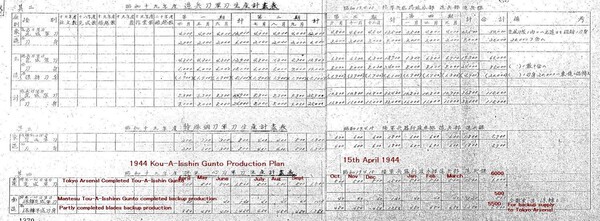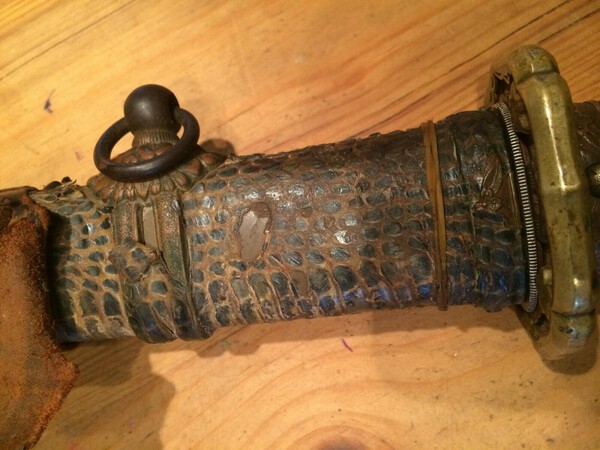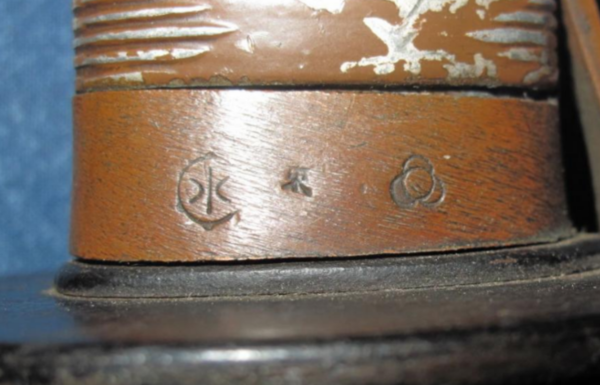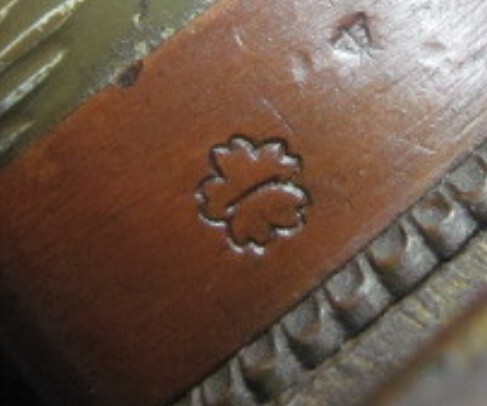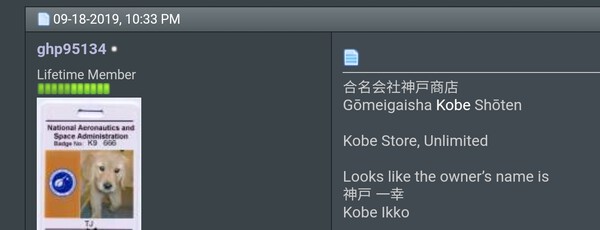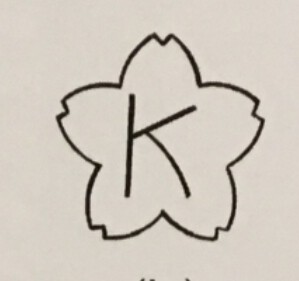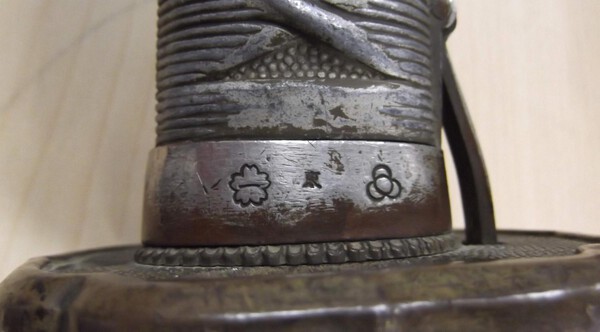-
Posts
13,018 -
Joined
-
Last visited
-
Days Won
155
Content Type
Profiles
Forums
Events
Store
Downloads
Gallery
Everything posted by Bruce Pennington
-

Attention Mantetsu Owners: A Survey
Bruce Pennington replied to Bruce Pennington's topic in Military Swords of Japan
Well, most factory-made products were, and still are, numbered. Bayonets, guns, etc, all had numbers. Don’t know why factories do it though. There were a small number of smiths that numbered their blades. -

Attention Mantetsu Owners: A Survey
Bruce Pennington replied to Bruce Pennington's topic in Military Swords of Japan
I would still like to hear Morita-san's thoughts on why the school kids kept records of the serial numbers they polished, and a clarification as to how certain we are the blades were actually produced at Mukden. I've attached the updated document (4.0) which includes these new numbers and I've attached the chart showing the serial number flow using the iroha method. mantetsu serial numbers (1).pdf -

Attention Mantetsu Owners: A Survey
Bruce Pennington replied to Bruce Pennington's topic in Military Swords of Japan
Trystan, I see it now, thanks! This would also clear up my question about how many blades were being produced per year. Serial numbers in this range would still fit the 6,000/year number. The '45s are: I 57, 90, 213, 289, and 449. -

Attention Mantetsu Owners: A Survey
Bruce Pennington replied to Bruce Pennington's topic in Military Swords of Japan
Oh My Gosh! What a significant find! It's amazing that you even found such a book. So, this confirms that Mantetsu blades were being made in the Mukden armory, and that the Konan-essei slogan on blades was real. I backs up the actual blade we have, both in slogan and in serial number as as a faker would not have know that "I" was the katakana of 1945. By the span of serial numbers, it shows that many were made that year (at least 1189). I have a question about the 1944 numbers: If I am reading them right, there are 5-digit numbers? Se 11596, 11151,11193, 11767, and the last one is confusing as it looks like 11(upside-down 2)15 or is it a poorly written 1135? What do you make of the 4 and 5 digit numbers Morita-san? The highest output I've read about is 400 per month (4,800 blades per year), but with Nick Komiya's 1944 document ordering Mantetsu to produce 6,000 unfinished blades for the Tokyo arsenal, PLUS these very high serial numbers, it appears Mantetsu was making considerably more blades than 4,800 per year. What do you think? I've attached the document Nick Komiya found. It seems to say that there were 6,500 Koa Isshins to be produced in 1944 (5,500 unfinished blades to go to Tokyo arsenal). That would make the 5-digit numbers seem odd. Sorry for so many questions! But why is it, do you think, that high school kids would have kept the serial numbers of the blades they polished? I don't doubt that they did, but why would they? Thank you so much for the new info, this is fantastic! PS: Another question- You said this confirms that Mukden was making Mantetsu blades. Does the book state that? Or were you infering that because the kids were polishing blades there? I ask because of the document Nick Komiya found ordering unfinished blades for the Tokyo factory to finish. If SMR was doing that for Tokyo, it is possible they were doing it for Mukden too. So it would be important to know, from the book, if they were saying that Mukden was making the blades, not just finishing them. Thank you again! -

A look at the Japanese Imperial Household Dirk
Bruce Pennington replied to matthewbrice's topic in Military Swords of Japan
For those not on Warrelics, I thought I'd post this link. Nick Komiya uncovered a document about non-standardized Navy Police Dirks. Prior to 1891, when the standard was set, they were up to personal taste and designs varied greatly. The post originator shows one that seemed to have a navy dirk in a police saya, but there were things not right about the saya, too. Nick found out why! http://www.warrelics.eu/forum/Japanese-militaria/unknown-Japanese-dirk-745042/ A shot of the dirk: -
I totally missed the "Ikko" part of Guy's translation of that newspaper ad. That is too strong of a coincidence! I have seen other stamps where it is the first kanji of a name ("伊” the first character of the name of sword smith 伊奈波兼吉(Inaba Kaneyoshi) comes to mind) or Fuku for Fukuoka. And considering the fact that there are no other known sword makers that were involved in the Type 95 process, the evidence is definitely leaning to "K" for Kobe and "一" for Ikko. Why the switch would be great to find out. On the Gifu to Seki discussion - I have read that the Seki group abandonded the "Seki" stamp when the Nagoya Arsenal started using it, so I had assumed the order to have flowed in the other direction: Seki ---> Gifu. It would take some investigating to see some dates on blades bearing both stamps to pin it down.
-
Nice examples, Steve, thanks!
-
Snakeskin is quite different, see the pic below. Hard to date a tsuba. There is a "late-war" canvas found in late-war navy tsuba, but not all tsuba made at the end of the war had them.
-
Perfect Ernie, thanks!!! Added to the Stamps Doc.
-
It’s rayskin like me the army. Navy simply laquered It black.
-
Well shoot. With my bad eyes and those original pics, I mistook the "0" for a shop stamp. Sorry, but much better pics, BTW! I can see what you mean about the original black tsuba being overcoated with the copper finish. Odd.
-
It’s nothing special Austus. I just collect stamps and am curious about the one on your fittings.
-

What's the most you spent on a sword?
Bruce Pennington replied to piryohae3's topic in General Nihonto Related Discussion
The most I've spent is $2,400 (twice). One for a copper-handled Type 95 and another for a Kaigunto with a koto blade and rayskin saya. But I've got a pretty small hobby fund. -
Austus, Could I get a good clear pic of that stamp inside the fuchi and backside of the seppa?
-
Ernie & Steve, Thanks for verifying all this! Ah, the round Seki! I had forgotten about that one! I've seen partials on fuchi, but never a good, complete one. If one of you guys have a good example, I'll add it to the Stamps Document. There are examples of it on the foil Seki acceptance stickers on saya, but I don't have a good one on fuchi. Ok, so there's now 2 guys I trust who are saying the evolution from "K" to "一" (Kobe Shoten) has merit. Well, I'm going to move the Ichi stamp out of "Unknowns" then, and put it down as a "Possibly later Kobe".
-
You might as well add: ホ (Miso) Thomas, I don't doubt what you are saying, as you are uncovering an amazing amount of previously unknown info, critical info, to our collecting world; BUT it would be helpful to us all if you could expound, or provide some of the evidence of Kokura's 1st arsenal producing blades. We have been hearing from some pretty knowledgable people, for years, that Kokura was administrative oversight and didn't produce gunto. It would help to see some of the evidence you are reading (with English edits, like Nick Komiya does). As a counter idea, though, I have always taken examples like you provided above, to mean that someone else made a blade, like Nagoya, and it's final inspection came by Kokura inspectors. For the first several years, Nagoya and Seki production was under Kokura supervision. It was somewhere around 1942ish that Kokura's role was decommissioned and Nagoya and Tokyo 1st took over.
-
Ok, while what you propose is possible, we really don't have any proof. The arsenals were given blocks of numbers to use on their blades. The blades themselves were made by a few contractors. We can speculate that K and 一 were from the company, however they could have been from two different companies. We just don't know. But it's an idea to watch. SEKI - You lost me. When or where was "刀" used to mark Seki-made blades?
-

Need Help With WW II Katana Blade ID
Bruce Pennington replied to keno's topic in Military Swords of Japan
Ken, Appears to be a standard Type 98 Japanese officer sword. You can read more than you ever can know at Ohmura's site: http://ohmura-study.net/900.html Hard to tell if traditionally made or not due to condition of the blade, but my guess is non-traditional. Doesn't mean "machine made", that's a misnomer. Mostly it means oil-quenched rather than water, but he nihonto guys can give you a more expert opinion on that. The wood/leather cover is often called a combat saya. The all-brown tassel is now believed to be used by the ciivian forces that worked with the army, called Gunzoku (read about it here:http://www.warrelics.eu/forum/Japanese-militaria/what-were-regulations-army-civilian-employees-carry-swords-701783/). Both the NCO and officer equivelants were authorized to wear Type 98 officer gunto. -
Is that what the kanji means? That has a very suspicious resemblance to “Misuno”!!! Maybe we just figured out which stamp came from the Misuno company! Thanks Trystan!
-
-
After re-reading all this, I can see I've misunderstood. We are not talking about the "Ichi" stamp, you (Thomas) simply introduced a new topic about the manufacturer named "合名会社神戸商店". I re-read the post where George Trotter posted that ad from them and cannot find which gunto in the previous thread he was refering too. The name was translated by Guy, at Warrelics, as "Kobe Shoten". I confused the issue by thinking we were talking about the "Ichi" stamp. Kobe, as postulated by Ohmura, used the "K" stamp.
-
But since it's in Japanese, there are very few of us who can profit from it. We could all use a name to call this contractor. I'll run this name and ad by Nick Komiya and see if he can break the code for us. Thomas, How is it that you've linked this name to the "Ichi" stamp? Was it through George Trotter's suggestion, or another source?
-
-

A look at the Japanese Imperial Household Dirk
Bruce Pennington replied to matthewbrice's topic in Military Swords of Japan
Very cool, Matt! Was it a "chance" find, or something you were searching for? -
Thomas, that's fantastic! Before you joined us, Nick Komiya, over on Warrelics.com, was our only researcher that could dig into the old war records and give us insight from them.


